
Undersecretary of Rural Development Dallas Tonsager (left) admired Helene's Hilltop Orchard's apple crop last fall with owner of Dave Pagoria. The company, in Merrill, Wisconsin, installed solar panels in its processing building last year with USDA rural development support.
Lost in this year’s drama over the Farm Bill is the 40th anniversary of the Rural Development Title, a threatened section in this year’s deliberations, whenever the next measure is passed.
While the roots of federal rural development policy can be found in Franklin Delano Roosevelt’s efforts to rebuild rural America during the Great Depression of the 1930s, it wasn’t until 1972 that a bipartisan rural development title was included in the Farm Bill.
This was a watershed event. It was an effort to bring together diverse programs that helped rural areas and moved rural development under the umbrella of the U.S. Department of Agriculture (USDA).
It also marked a transition from Lyndon B. Johnson’s War on Poverty, that had focused mainly on urban areas, to a more clearly defined rural development and anti-poverty policy based on building business and infrastructure.
In 1966, two years after announcing the War on Poverty, Johnson appointed the National Advisory Commission on Rural Poverty with a huge scope, including “a comprehensive study and appraisal of the current economic situations and trends in American rural life, as they relate to the existence of income and community problems of rural areas”; those situations and trends included low income, farm labor, unemployment and underemployment, and the needs for retraining, rural economic development and expanded opportunities.
Resource Books The Lyndon Johnson administration commissioned and received "The People Left Behind," a federal report on rural poverty.
The commission issued its report, The People Left Behind, to Johnson in September 1967. Before having a chance to implement fully the commission’s recommendations, Johnson – now a political casualty of his unpopular Vietnam War – announced his decision not to seek re-election in March 1968.
After Richard M. Nixon’s election to the presidency in 1968, he appointed a Task Force on Rural Development to help outline his policy direction. The report, like the previous administration’s, connected rural and urban well-being, mainly focusing on helping rural communities slow the migration to cities and develop community leaders. The basis of Nixon’s policy was a different level of federal involvement based on the idea of revenue sharing with states and local rural governments.
As Dennis Roth points out in a history of rural development under Nixon, the president wanted to reshape federal-state relationships, giving communities federal funding while providing more flexibility in their decision-making to meet local needs and aspirations. The Task Force, in a different interpretation from The People Left Behind, stated that rural development could not work unless the local community actively worked for it. According to Nixon’s advisors, if "a community lacks leadership, if it lacks local concern, if it isn't convinced that it should become a better place to live - then perhaps it shouldn't.”
Nixon’s philosophy was to withdraw Washington from local-decision making while providing federal technical assistance. Before passage of the rural development title in 1972, the administration moved toward its goal of formulating a more coherent policy along these lines in a complicated series of internal reorganizations within USDA.
According to Anne B.W. Effland, the Agriculture Act of 1970 had outlined a rationale for federal rural development policy when Congress committed itself to "a sound balance between rural and urban America,"
The Nixon Administration’s actions before passage of the Farm Bill in 1972 included the following:
1970
• The Extension Service was given leadership of USDA’s "outreach."
• A departmental Rural Development Committee replaced the Rural Community Development Service as coordinator of USDA’s rural development programs.
1971
• USDA set up state-level rural development coordinators under the newly resurrected Rural Development Service, a successor to the Rural Community Development Service.
• The first Regional Rural Development Center was set up to carry out regional extension and research for rural development.
The new Farm Bill with its rural development title (H.R. 12931, Public Law 92419 (86 Stat. 657)) was signed on August 30, 1972. In his statement to Congress, Nixon outlined provisions of the bill, which had “finally” been enacted, including:
• new loans for commercial and industrial development in communities with populations under under 50,000 and for various local facilities in communities with populations under 10,000;
• insured and guaranteed, rather than direct federal loans, to press the private sector into playing a major role in rural development and limit the inflationary impact on the federal budget;
• cost-sharing provisions including water quality and natural resource conservation;
• improvements in the administrative machinery of the Farmers Home Administration.
The Farmers Home Administration, which had led community development work since the New Deal in the 1930s, was shifted into a seeingly diminished role. A 1973 reorganization of the Community Services Division created three divisions: Water and Waste Disposal, Community Facilities Loans, and Business and Industry Loans.
FmHA continued to loan its own funds in a number of programs and took on the additional task of insuring funds loaned through private sources, according to Roth. Despite the administrative changes, the agency continued to receive the highest share of USDA rural development appropriations, as it had under John F. Kennedy and Johnson.
This was a time of federal budget instability, so, despite the attention Nixon was paying to rural development, the amount Congress authorized was less than had been dedicated to this goal in the years before disparate rural development disparate programs were pulled together under one title.
Darryl Heikes/UPI President Richard Nixon, shown here in March 1971, sought a $1.1 billion revenue sharing program for rural America. He later expressed disappointment at the development component of the 1972 Farm Bill. Nixon had viewed the 1972 rural development title as a first step. He did not get all that he wanted; for example, he had hoped to divide USDA into four new departments, including one for community development in rural and urban areas. Nixon intended this proposal to streamline government operations but the idea faced resistance in Congress because of the feeling that urban areas might come to dominate the new unit’s operations.
Nixon expressed his disappointment in a message to Congress: “The most disconcerting feature of this act is that it does not include one of my most important proposals for rural development, the substitution of special revenue sharing for categorical grants, and instead creates a number of new categorical grant programs. That means more decision making in Washington instead of decentralized decision making at the State and local level.”
He also noted that the act, if fully funded, would add $400 to $500 million in expenditures to the federal budget at a time when it had already been overloaded with large spending increases by the Congress.
Nixon's disappointment with the 1972 act points to a number of problems that bedeviled rural development legislation over the past 40 years. Rural observers and other pundits always seem to see passage of the Farm Bill as a Washington mini-drama. In reality it is a food bill that affects everyone in the country. Over time it has become subject to intense pulling and hauling by constituents with varying degrees of power and influence, and often with conflicting interests also. Rural development, cherished by many of us, has always been a minor component of the overall Farm Bill, and is treated as such even though there are more non-farmers in rural America than farmers.
A further lesson (and perhaps an irony) from the Nixon Administration is that in times of tight budgets, rural development is especially subject to cuts; it was so even at that historic moment when the president and Congress were pulling together disparate pieces of legislation under a single title in the Farm Bill.
Photo at right: USDA's rural development title has included support for businesses. David Thigpen (left), a USDA Business Program Specialist, bought clothing of his alma mater Eastern Carolina Univ. at the Mortex Factory Outlet in Wendell, NC, from Chris Morrell (center) and Brigitte Sanford (right).
 With rural development programs again under threat after a number of years of budget cutting, USDA has taken particular pains to tell its story and point out where its RD programs are working. The agency’s website includes “quick facts” about funding activities and a map of states so readers can click and find selected success stories. With rural development programs again under threat after a number of years of budget cutting, USDA has taken particular pains to tell its story and point out where its RD programs are working. The agency’s website includes “quick facts” about funding activities and a map of states so readers can click and find selected success stories.
Given the difficulties of assessing program impacts, USDA has provided a number of examples. In some cases, these examples seem to assume wider impacts of the direct USDA grant or loan, including other businesses and job retention or creation. For example, USDA cites:
Business: Provided over 12,000 grants and loans to assist over 50,000 rural small businesses in creating or saving 266,000 jobs;
Energy: Invested $800 million in bio-refineries, renewable energy and energy efficiency; funded projects in all 50 states, supporting 5,733 renewable energy and energy efficiency projects nationwide; generated or saved enough power to meet the annual needs of 600,000 households; and provided $192 million in grants and $165 million in loan guarantees to agricultural producers and rural small business owners for renewable energy systems and energy efficiency improvements.
It is difficult to gauge failures in rural development using this approach, but two things are clear:
-- USDA is engaged in a wide range of activities that offer rural communities and regions chances to build and rebuild critical physical infrastructure, develop businesses, and enhance broadband capacity.
-- The rural development appropriation is a small part of the overall federal budget, but it can have significant impacts on communities that have been left behind but are trying to catch up.
Timothy Collins is assistant director for research, policy, outreach, and sustainability at the Illinois Institute for Rural Affairs at Western Illinois University in Macomb. Opinions expressed here are his and his alone.
|




 With rural development programs again under threat after a number of years of budget cutting, USDA has taken particular pains to tell its story and point out where its RD programs are working. The agency’s website includes “quick facts” about funding activities and a map of states so readers can click and find selected success stories.
With rural development programs again under threat after a number of years of budget cutting, USDA has taken particular pains to tell its story and point out where its RD programs are working. The agency’s website includes “quick facts” about funding activities and a map of states so readers can click and find selected success stories.



